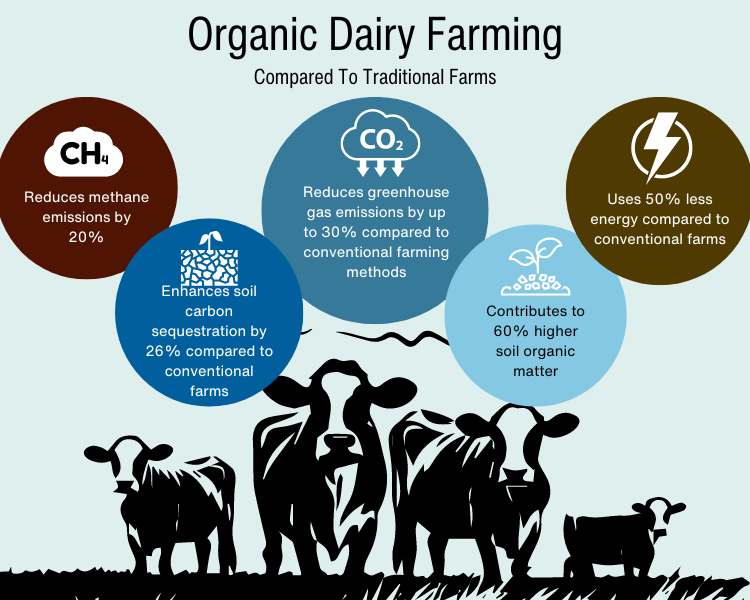Are organic dairy farms paving the way for a healthier planet?

Published: August 14, 2024
Category: Organic News
Organic dairy farming is not just a trend; it’s a powerful solution for combating climate change. By using sustainable practices, organic dairy farms are reducing greenhouse gas emissions, improving soil health, and supporting biodiversity.
Since dairy farming has a serious impact on the carbon footprint of every dairy product, organic farms utilize new technology and ancient practices to generate a sustainable future through stewardship.
This article explains how these farms are making a positive impact and leading the way towards a greener future.
Reducing Greenhouse Gas Emissions
One of the most significant ways organic dairy farms contribute to a healthier planet is by reducing greenhouse gas emissions. Research shows that organic dairy farming can reduce these harmful gases by up to 30% compared to conventional farming methods [1].
These farms are also actively working to lower milk carbon emissions through sustainable practices and innovative technologies,[6] which further cuts down on methane emissions—a potent greenhouse gas.
Methane is produced during the digestion process of cows and from manure storage. By feeding cows a more natural diet and managing manure effectively, organic dairy farms can reduce methane emissions by 20% [3].
Enhancing Soil Health
Soil health is crucial for the environment, and organic dairy farms play a vital role in enhancing it. These farms use practices that improve soil structure, increase organic matter, and promote biodiversity.
Organic farming methods, such as composting and crop rotation, help build healthier soils that can sequester more carbon.
Studies have shown that organic farms can enhance soil carbon sequestration by 26% compared to conventional farms [2]. This means that organic soils can absorb and store more carbon dioxide from the atmosphere, helping to mitigate climate change.
Additionally, organic dairy farms contribute to 60% higher soil organic matter, which improves soil fertility and supports plant growth [5].
Lowering Energy Use
Another benefit of organic dairy farming is its lower energy use.
Organic farms tend to use less energy because they rely on natural processes and reduce the need for synthetic inputs like fertilizers and pesticides. This not only saves energy but also reduces the carbon footprint of dairy farming.
Organic dairy farms use 50% less energy compared to conventional farms [4]. This significant reduction in energy use helps lower overall greenhouse gas emissions and promotes a more sustainable farming system.
By relying on natural methods and renewable resources, organic dairy farms are paving the way for a more energy-efficient future.
Supporting Biodiversity
Biodiversity is essential for a healthy ecosystem, and organic dairy farms are champions of biodiversity.
These farms create environments that support a wide range of plants, animals, and microorganisms. By avoiding synthetic chemicals and practicing crop rotation, organic farms provide habitats for various species and promote ecological balance.
The presence of diverse plant species on organic farms also attracts pollinators like bees and butterflies, which are crucial for food production. Additionally, organic farming practices help maintain healthy populations of beneficial insects and soil organisms that contribute to nutrient cycling and pest control.
Promoting Animal Welfare
Organic dairy farming is not just about the environment; it also focuses on animal welfare.
Organic standards require that cows have access to pasture, fresh air, and sunlight. They are fed organic feed and are not given synthetic hormones or antibiotics. These practices ensure that cows live healthier and happier lives
Happy and healthy cows produce better quality milk, which is beneficial for consumers. By prioritizing animal welfare, organic dairy farms set a higher standard for ethical farming practices and contribute to the overall well-being of animals.
Future of Organic Dairy Farming
The future of organic dairy farming looks promising as more people recognize its environmental and health benefits. Advancements in organic farming practices, increased policy support, and ongoing research are helping to expand the reach of organic dairy farming.
Researchers are continually exploring new ways to improve organic farming methods, such as developing better organic feed and enhancing soil health techniques. Policy support at local and national levels is also crucial in promoting organic farming practices and providing resources for farmers to transition to organic systems.
Moreover, consumer demand for organic products is rising, encouraging more farmers to adopt organic practices. As the market for organic dairy products grows, it supports the sustainability and viability of organic dairy farms.
Organic dairy farming is a powerful tool in the fight against climate change and the journey towards a healthier planet. By reducing greenhouse gas emissions, enhancing soil health, lowering energy use, supporting biodiversity, and promoting animal welfare, organic dairy farms are setting a positive example for sustainable agriculture.
Looking to the future, continued advancements and support for organic dairy farming will play a crucial role in creating a more sustainable and resilient food system.
And one that reduces the carbon footprint of dairy to levels that are healthy for the planet.
References
[1] Aguirre-Villegas, H. A., Larson, R. A., Rakobitsch, N., Wattiaux, M. A., & Silva, E. (2022, August 20). Farm level environmental assessment of organic dairy systems in the U.S. ScienceDirect. Retrieved July 5, 2024, from https://www.sciencedirect.com/science/article/pii/S095965262201993X?via%3Dihub
[2] The Organic Center. (2017, September 11). Northeastern University and The Organic Center Release Groundbreaking Study. The Organic Center. Retrieved July 5, 2024, from https://www.organic-center.org/research/northeastern-university-and-organic-center-release-groundbreaking-study
[3] University of Minnesota. (2023, June 26). Can kelp create healthier cows and a healthier planet? West Central Research and Outreach Center. Retrieved July 5, 2024, from https://wcroc.cfans.umn.edu/news/kelp-2023
[4] Brook, L. (2022, June 9). Organic Agriculture Helps Solve Climate Change. Natural Resources Defense Council. Retrieved July 5, 2024, from https://www.nrdc.org/bio/lena-brook/organic-agriculture-helps-solve-climate-change
[5] Pimentel, D., & Burgess, M. (2014, January 1). An Environmental, Energetic and Economic Comparison of Organic and Conventional Farming Systems. Springer Link. Retrieved July 5, 2024, from https://link.springer.com/chapter/10.1007/978-94-007-7796-5_6
[6] Kilgore, G. (2024, March 27). Carbon Footprint of Milk vs Soy Milk vs Almond Milk vs Oat (per Gallon, Kg). 8BillionTrees.com. Retrieved July 5, 2024, from https://8billiontrees.com/carbon-offsets-credits/carbon-ecological-footprint-calculators/carbon-footprint-of-milk/
Organic & Non-GMO Insights August 2024




